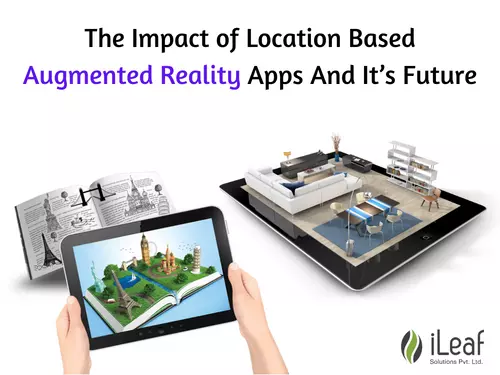The Impact of Location Based Augmented Reality App And It’s Future

Augmented Reality apps have taken over the world like crazy. Still being a wonder for many people, this technology has the power to change the current face of the technology as well as the world. 2018 has seen an increased interest in augmented reality as the technology becomes more easily available to users everywhere. In a nutshell, Augmented Reality(AR) works by layering 2D or 3D virtual content on top of real-world locations and objects, which can be accessed using smart devices such as phones, and tablets and also wearable technology such as smart glasses. Augmented reality apps can work on commonly available smartphones and headsets, unlike virtual reality games and apps that need investment in dedicated headsets. This paves the way for the widespread distribution of AR apps. From popular social networking apps like Snapchat to product promotion apps like IKEA’s catalog, a thriving market for AR applications has been created across all sectors as a result of the consumer adoption of AR.
In 2016 the world went crazy for Pokemon Go. This application made the people think we can also create a world of fantasy not only in our dreams but within our mobile screen reality as well. And while the great popularity of this game is slowly decreasing, augmented reality becomes a new trend in the tech world and is confidently grabbing the market share. In 2017, the AR market reached more than $14.1 billion and is expected to reach $209.2 billion by 2022. What’s more, the number of AR users is expected to grow up to 1 billion by 2020
Besides the game industry, many other business areas can profit from implementing augmented reality apps. One of the types of augmented reality called location-based or markerless augmented reality will be the spotlight of this article.
Classification of Augmented Reality Apps:
- Marker-based AR
- Marker-less or location-based AR
- Projection-based AR
Superimposition-based ARMost AR apps today fall into the first two categories – marker-based AR and location-based AR. Marker-based AR primarily uses image recognition features to display virtual information overlaid on specific objects.
Understanding of Location-Based Augmented Reality:
Location-based Augmented Reality is also known as markerless, position-based, and geo-based augmented reality. It doesn’t need special markers to identify the place where a virtual object should appear which is in contrast with marker-based AR.
It primarily relies on GPS, accelerometer, digital compass, and other technologies to identify the phone’s location and position with a high level of accuracy. Through the fact that all modern devices are equipped with these sensors, augmented reality is available for every mobile device owner.
The biggest question is how does augmented reality work and how does it get the information about the location. The mechanism of work of such an app is as follows: your application sends queries to sensors, after the app gets the needed data, the app compares it with information about points of interest and defines where it should add virtual data to the real world.
Markerless AR can be divided into outdoor and indoor. Outdoor augmented reality uses GPS, while indoor recognizes the current location of a mobile device with the help of beacons. The accuracy of the Location-Based Augmented Reality mainly depends on the GPS(Global Positioning System) and with the GPS data, we place the 3D assets.
Steps to create a location-based AR app:
So, if you like the idea of a location-based augmented reality app, you’ll probably want to get started. As we’ve seen, these apps can be incredibly complex, but if you break the development process down, it should become much easier.
1. Determine what resources you need
Depending on the complexity of your app, you need to determine what resources are needed – that could be anything from data to other frameworks and services will be required. For example, You’ll need to use Unity to build in that level of functionality and realism if you plan to create a game with 3D objects.
2. Choose the right augmented reality tool
There are a huge number of available augmented reality software development kits out there.
However, rather than wade through every single one, here are some of the best to get started with.
1. AR Kit by Apple
AR kit from Apple features just about everything you’d need to develop an augmented reality application. For example, it has a technology that allows combining both computer vision and camera data to track the user’s environment. AR Kit also can adjust the light level in the virtual model, to respond to the level of light in the real world.
ARKit 2 recently brought users several cool new features. For example, it allows you to build interactivity into your application, and also allows you to build ‘memory’ into your app so it can ‘remember’ the location of augmented reality objects.
2.ARCore by Google
In Google’s ARCore you’ll find a mapping tool that is particularly useful for developing location-based apps. ARCore can also track motion and detect vertical and horizontal surfaces. In the latest version of ARCore users can take two gadgets and work with one AR object from different viewing angles.
3. Geolocation data should be added
Not all SDKs provide a mapping feature. If it doesn’t, it’s essential to make sure you add in geolocation data. Without it, the app won’t work! We have already seen that GPS technology is typically used. It’s convenient and it can detect a user’s location anywhere. It can, however, consume a lot of energy. Location services on iOS and Android will help to activate geolocation on the device.
Challenges you are going to face when building a Location-Based Augmented Reality App:
- Even when users move their cameras, the virtual objects should stay in their place.
- Accuracy is a critical factor for an app of this type. Your app should send queries to all needed sensors correctly and simultaneously to provide a high level of accuracy. The attitude and position of the phone should be taken into account.
- Techniques that calculate the distance between your phone and the needed object should be reliable and efficient. Make sure that implemented GPS works without errors.
Future Impact of LBAR applications:
The use of location-based markerless augmented reality apps can become a great way of improving the traveling experience. Hence, now it is widely used particularly in this sphere. It helps tourists discover new places and quickly find the most popular sightseeing in a real-time mode using their mobile devices. Navigation applications with location-based augmented reality can dramatically improve the effectiveness of navigation systems. For instance, a traveler can find the nearest restaurant by simply pointing the camera at the street.
Our Focus on Location-Based Augmented Reality apps:
We at iLeaf Solutions are focusing on LBAR(Location-Based Augmented Reality) technology with an application currently unnamed but we call it “CALM AR”. We use the LBAR and apply it to existing sewage data of many regions in the United Kingdom. Using Calm AR we help the sewer maintenance team easily identify the affected sewers and their piping, thus helping the team to track all the joining pipes. We performed a lot of analysis before starting CALM AR and still, we are analyzing it. The above-mentioned features and drawbacks are our analysis for the past 18 months. We are now finding a possible way of solution to rectify the LBAR limitation and build a more efficient system than now because we always seek to make it better for the future.
Some Cool LBAR SDK:
- ARKit(Apple)
- ARCore(Google)
- Wikitude
For sure, building high-quality markerless GPS-based Augmented Reality apps is no piece of cake. For an application to be truly entertaining, it has to be accurate and natural. Once you understand how GPS data and Augmented Reality can work together, your application can easily catch your eyes. Accuracy is what we need to make a reliable Augmented Reality app.














